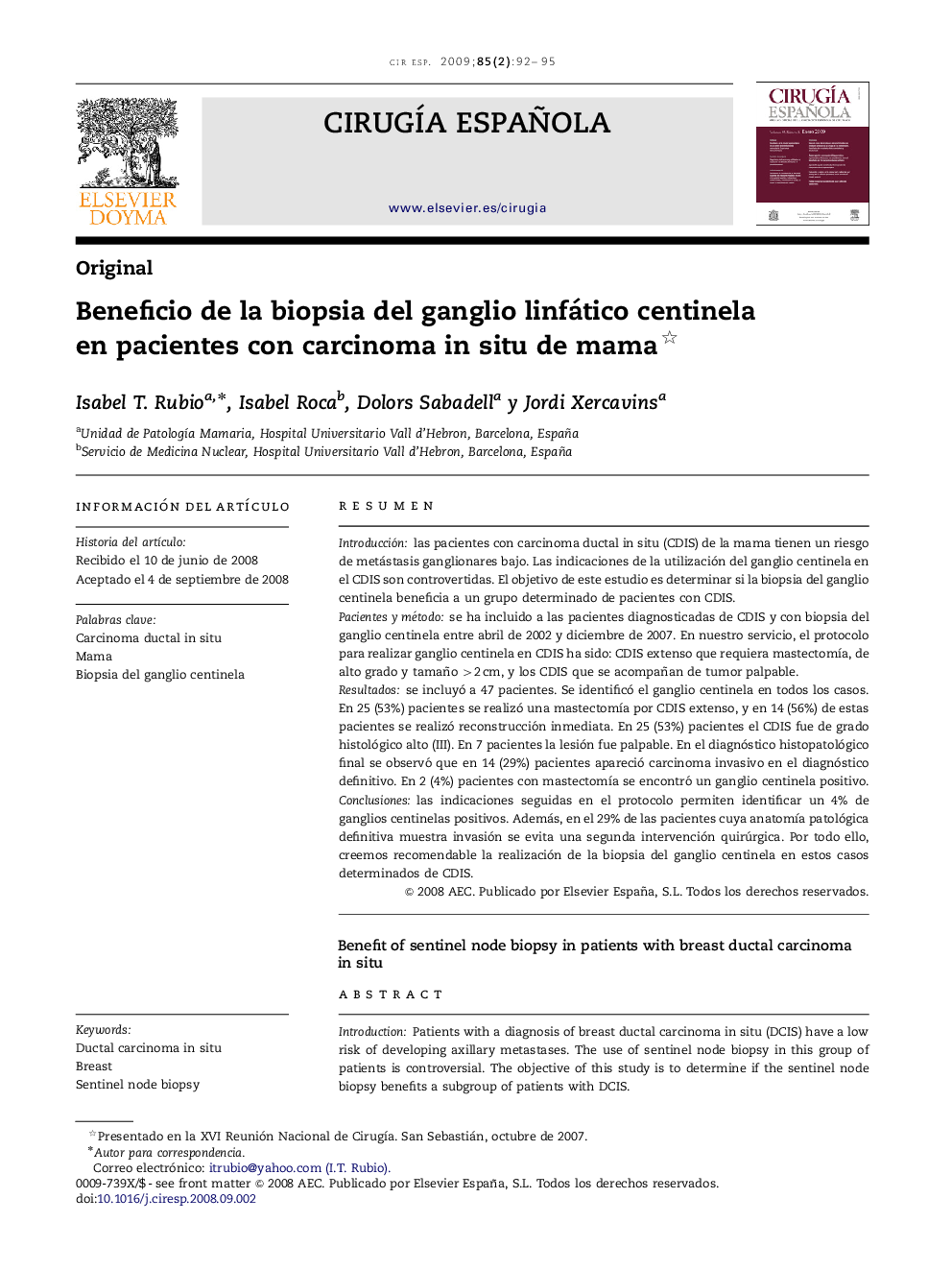| Article ID | Journal | Published Year | Pages | File Type |
|---|---|---|---|---|
| 4253386 | Cirugía Española | 2009 | 4 Pages |
ResumenIntroducciónlas pacientes con carcinoma ductal in situ (CDIS) de la mama tienen un riesgo de metástasis ganglionares bajo. Las indicaciones de la utilización del ganglio centinela en el CDIS son controvertidas. El objetivo de este estudio es determinar si la biopsia del ganglio centinela beneficia a un grupo determinado de pacientes con CDIS.Pacientes y métodose ha incluido a las pacientes diagnosticadas de CDIS y con biopsia del ganglio centinela entre abril de 2002 y diciembre de 2007. En nuestro servicio, el protocolo para realizar ganglio centinela en CDIS ha sido: CDIS extenso que requiera mastectomía, de alto grado y tamaño >2 cm, y los CDIS que se acompañan de tumor palpable.Resultadosse incluyó a 47 pacientes. Se identificó el ganglio centinela en todos los casos. En 25 (53%) pacientes se realizó una mastectomía por CDIS extenso, y en 14 (56%) de estas pacientes se realizó reconstrucción inmediata. En 25 (53%) pacientes el CDIS fue de grado histológico alto (III). En 7 pacientes la lesión fue palpable. En el diagnóstico histopatológico final se observó que en 14 (29%) pacientes apareció carcinoma invasivo en el diagnóstico definitivo. En 2 (4%) pacientes con mastectomía se encontró un ganglio centinela positivo.Conclusioneslas indicaciones seguidas en el protocolo permiten identificar un 4% de ganglios centinelas positivos. Además, en el 29% de las pacientes cuya anatomía patológica definitiva muestra invasión se evita una segunda intervención quirúrgica. Por todo ello, creemos recomendable la realización de la biopsia del ganglio centinela en estos casos determinados de CDIS.
IntroductionPatients with a diagnosis of breast ductal carcinoma in situ (DCIS) have a low risk of developing axillary metastases. The use of sentinel node biopsy in this group of patients is controversial. The objective of this study is to determine if the sentinel node biopsy benefits a subgroup of patients with DCIS.Patients and methodBetween April 2002 and December 2007, patients with a diagnosis of DCIS and who underwent a sentinel node biopsy were included in the study. In our centre the sentinel node biopsy was performed in patients with DCIS who required a mastectomy, high grade and >2 cm DCIS and palpable DCIS.ResultsForty-seven patients were included in the study. In all cases the sentinel node was identified. Twenty-five (53.1%) patients underwent a mastectomy due to extensive DCIS; 14 of these (56%) with immediate reconstruction with implants. Twenty-five (53.1%) patients had high grade DCIS. In 7 (14.8%) patients the tumour was palpable. Fourteen patients (29.7%) were upgraded to invasive breast cancer in the definitive histology. In 2 (4.2%) patients who underwent a mastectomy a positive sentinel node was found.ConclusionsPerforming sentinel node biopsy in this group of DCIS patients has lead us to identify 4% of patients with positive sentinel nodes. Furthermore, 29.7% of the patients have avoided a second invasive diagnostic procedure for definitive histology. For these reasons we consider it appropiate to perform sentinel node biopsy in this subgroup of patients with DCIS of the breast.
